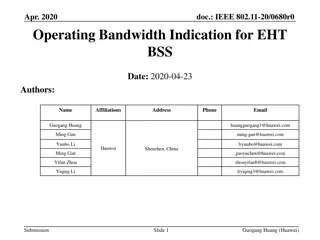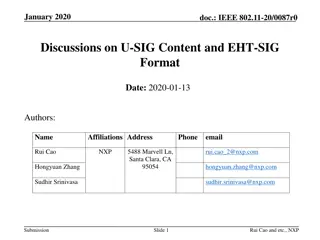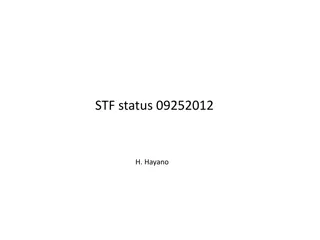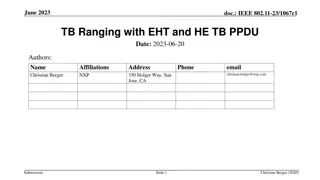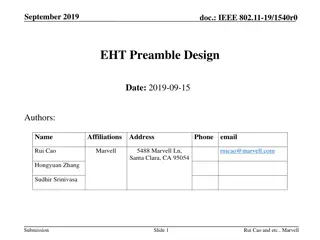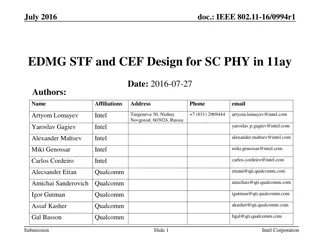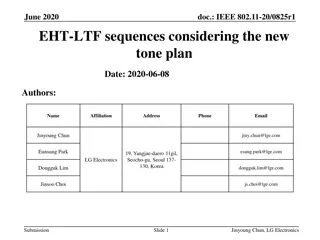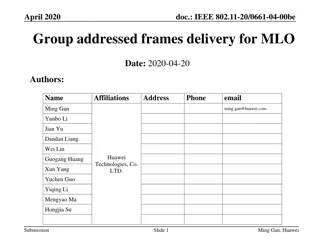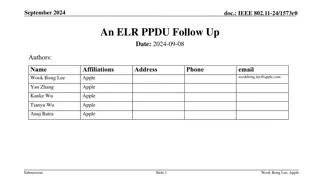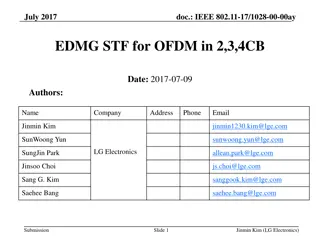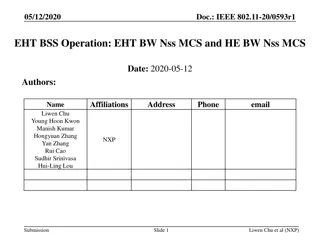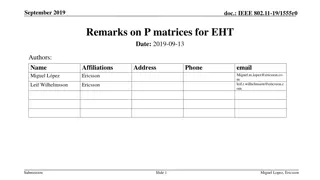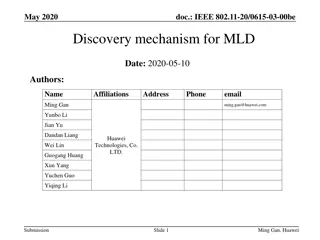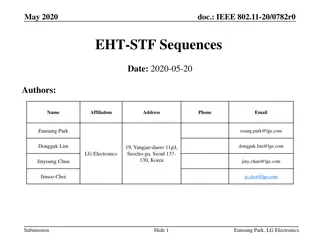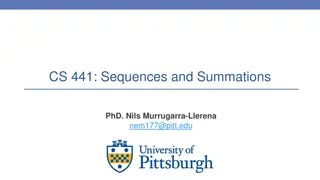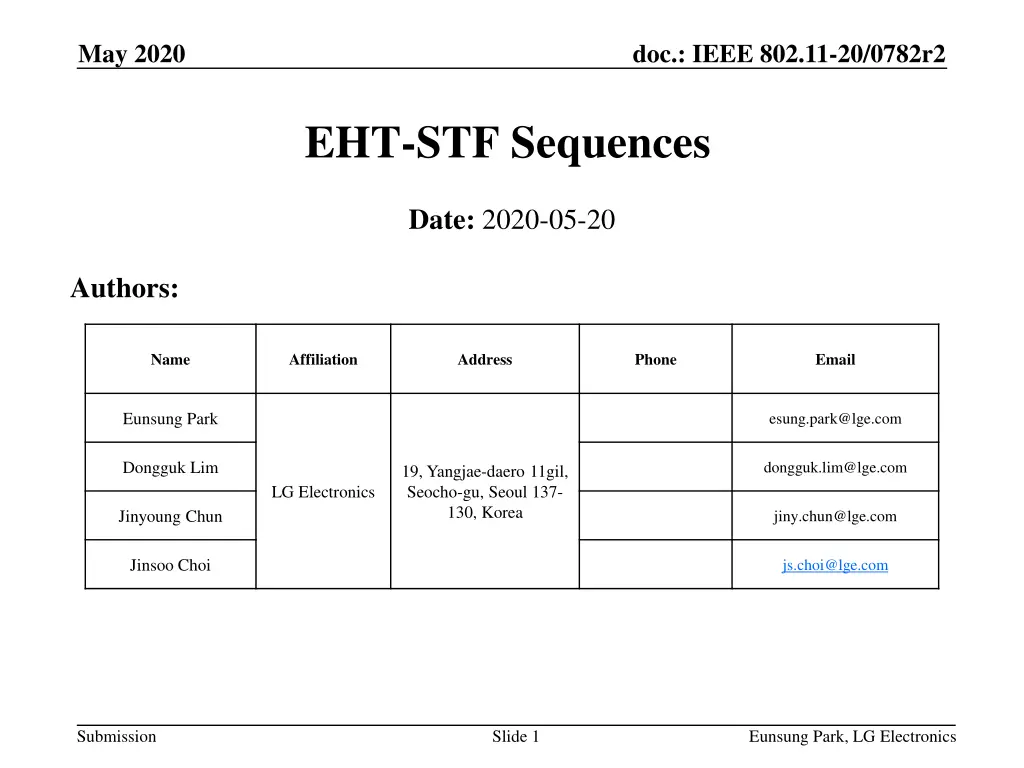
Optimal EHT-STF Sequences for IEEE 802.11-20/0782r2 Document
Explore the proposed 1x/2x EHT-STF sequences for 240/160+80 MHz in the IEEE 802.11-20/0782r2 document. These sequences are designed based on HE-STF sequences with additional phase rotation to enhance PAPR. The coefficients are optimized for improved feasibility, and comparisons with data parts are conducted. View the slides detailing the sequences and coefficients for contiguous and non-contiguous modes, optimized to minimize PAPR.
Uploaded on | 0 Views
Download Presentation

Please find below an Image/Link to download the presentation.
The content on the website is provided AS IS for your information and personal use only. It may not be sold, licensed, or shared on other websites without obtaining consent from the author. If you encounter any issues during the download, it is possible that the publisher has removed the file from their server.
You are allowed to download the files provided on this website for personal or commercial use, subject to the condition that they are used lawfully. All files are the property of their respective owners.
The content on the website is provided AS IS for your information and personal use only. It may not be sold, licensed, or shared on other websites without obtaining consent from the author.
E N D
Presentation Transcript
May 2020 doc.: IEEE 802.11-20/0782r2 EHT-STF Sequences Date: 2020-05-20 Authors: Name Affiliation Address Phone Email Eunsung Park esung.park@lge.com Dongguk Lim dongguk.lim@lge.com 19, Yangjae-daero 11gil, Seocho-gu, Seoul 137- 130, Korea LG Electronics Jinyoung Chun jiny.chun@lge.com Jinsoo Choi js.choi@lge.com Submission Slide 1 Eunsung Park, LG Electronics
May 2020 doc.: IEEE 802.11-20/0782r2 Introduction In [1], several straw polls relevant to EHT-STF were passed and the remaining issue is to decide 1x/2x EHT-STF sequences for 240/160+80/320/160+160 MHz We propose those sequences which are designed based on 1x/2x 80MHz/160MHz HE-STF sequences with additional phase rotation to improve PAPR We optimize the additional phase rotation coefficients assuming the tone plan proposed in [2] In addition, we compare PAPRs between the proposed EHT-STF sequences and the data part to verify their feasibility Submission Slide 2 Eunsung Park, LG Electronics
May 2020 doc.: IEEE 802.11-20/0782r2 1x/2x EHT-STF Sequence for 240/160+80 MHz (1/6) 1x/2x 80MHz HE STF sequence (80HES) is repeated and second and third 80MHz segments are multiplied by additional coefficients [80HESa*80HESb*80HES] Candidates of a and b are 1 and -1 as in 11ax Utilizing 80HES may be beneficial to implementation and PAPR of the 80MHz portion in the non-contiguous mode Submission Slide 3 Eunsung Park, LG Electronics
May 2020 doc.: IEEE 802.11-20/0782r2 1x/2x EHT-STF Sequence for 240/160+80 MHz (2/6) Proposed 1x EHT-STF sequence for contiguous 240MHz EHTS-1520:16:1520 = {M 1 -M 0 -M 1 -M -1*(0 M 1 -M 0 -M 1 -M) -1*(0 M 1 -M 0 -M 1 -M)} * (1+j) / sqrt(2) M = {-1 -1 -1 +1 +1 +1 -1 +1 +1 +1 -1 +1 +1 -1 +1} Coefficients are optimized by minimax approach (i.e., minimizing worst PAPR) considering all punctured cases approved in 11be as well as non- punctured one 1x EHT-STF in 240MHz 1 - All PAPRs of punctured and non-punctured cases are incorporated Similar trend can be seen as in 80MHz and 160MHz shown in Appendix PAPRs for the proposed EHT-STF sequence are way below that of the data part Proposed Data w/ QAM Data w/ BPSK 0.9 0.8 - 0.7 0.6 - CDF 0.5 0.4 0.3 0.2 0.1 0 0 2 4 6 8 10 12 14 16 18 20 PAPR [dB] Submission Slide 4 Eunsung Park, LG Electronics
May 2020 doc.: IEEE 802.11-20/0782r2 1x/2x EHT-STF Sequence for 240/160+80 MHz (3/6) Proposed 2x EHT-STF sequence for contiguous 240MHz EHTS-1528:8:1528 = {M -1 M -1 -M -1 M 0 -M 1 M 1 -M 1 -M -1*(0 M -1 M -1 -M -1 M 0 -M 1 M 1 -M 1 -M)-1*(0 M -1 M -1 -M -1 M 0 -M 1 M 1 -M 1 -M)} * (1+j) / sqrt(2) EHTS-1528 = EHTS-520 = EHTS-504 = EHTS504 = EHTS520 = EHTS1528 = 0 Coefficients are optimized by minimax approach considering all RUs and RU combinations as well as all punctured and non-punctured cases 2x EHT-STF in 240MHz 1 - All PAPRs of RUs and RU combinations as well as punctured and non-punctured cases are incorporated Similar trend can be seen as in 160MHz shown in Appendix The amount of PAPRs higher than the median point of the data part is less than 10% Proposed Data w/ QAM Data w/ BPSK 0.9 0.8 0.7 - 0.6 CDF 0.5 - 0.4 0.3 0.2 0.1 0 0 2 4 6 8 10 12 14 16 18 20 PAPR [dB] Submission Slide 5 Eunsung Park, LG Electronics
May 2020 doc.: IEEE 802.11-20/0782r2 1x/2x EHT-STF Sequence for 240/160+80 MHz (4/6) We propose to unify the sequence between contiguous and non- contiguous modes The unified sequence may be desirable from the implementation perspective For the 1x EHT-STF sequence, we obtained the same optimal coefficients when considering both contiguous and non-contiguous modes PAPR is shown in Appendix For the 2x EHT-STF sequence, certain RUs can be regarded as the non- contiguous portions which means we can consider that the selected coefficients shown in the previous slide are optimized under both contiguous and non-contiguous modes E.g., one of the 2x996 RUs can be regarded as the non-contiguous 160MHz portion Submission Slide 6 Eunsung Park, LG Electronics
May 2020 doc.: IEEE 802.11-20/0782r2 1x/2x EHT-STF Sequence for 240/160+80 MHz (5/6) Proposed 1x EHT-STF sequence for non-contiguous 160+80 MHz Low 160MHz + high 80MHz mode Low 160MHz: EHTS-1008:16:1008 = {M 1 -M 0 -M 1 -M 0 -M -1 M 0 M -1 M} * (1+j) / sqrt(2) High 80MHz: EHTS-496:16:496 = {-M -1 M 0 M -1 M} * (1+j) / sqrt(2) Low 80MHz + high 160MHz mode Low 80MHz: EHTS-496:16:496 = {M 1 -M 0 -M 1 -M} * (1+j) / sqrt(2) High 160MHz: EHTS-1008:16:1008 = {-M -1 M 0 M -1 M 0 -M -1 M 0 M -1 M} * (1+j) / sqrt(2) Submission Slide 7 Eunsung Park, LG Electronics
May 2020 doc.: IEEE 802.11-20/0782r2 1x/2x EHT-STF Sequence for 240/160+80 MHz (6/6) Proposed 2x EHT-STF sequence for non-contiguous 160+80 MHz Low 160MHz + high 80MHz mode Low 160MHz: EHTS-1016:8:1016 = {M -1 M -1 -M -1 M 0 -M 1 M 1 -M 1 -M 0 - M 1 -M 1 M 1 -M 0 M -1 -M -1 M -1 M} * (1+j) / sqrt(2) EHTS-1016 = EHTS-8 = EHTS8 = EHTS1016 = 0 High 80MHz: EHTS-504:8:504 = {-M 1 -M 1 M 1 -M 0 M -1 -M -1 M -1 M} * (1+j) / sqrt(2) EHTS-504 = EHTS504 = 0 Low 80MHz + high 160MHz mode Low 80MHz: EHTS-504:8:504 = {M -1 M -1 -M -1 M 0 -M 1 M 1 -M 1 -M} * (1+j) / sqrt(2) EHTS-504 = EHTS504 = 0 High 160MHz: EHTS-1016:8:1016 = {-M 1 -M 1 M 1 -M 0 M -1 -M -1 M -1 M 0 - M 1 -M 1 M 1 -M 0 M -1 -M -1 M -1 M} * (1+j) / sqrt(2) EHTS-1016 = EHTS-8 = EHTS8 = EHTS1016 = 0 Submission Slide 8 Eunsung Park, LG Electronics
May 2020 doc.: IEEE 802.11-20/0782r2 1x/2x EHT-STF Sequence for 320/160+160 MHz (1/7) We propose two options Option 1: 1x/2x 80MHz HE STF sequence (80HES) is repeated and second, third and forth 80MHz segments are multiplied by additional coefficients [80HESa*80HESb*80HES c*80HES] Candidates of a, b and c are 1 and -1 as in 11ax Utilizing 80HES may be beneficial to implementation Option 2: 1x/2x 160MHz HE STF sequence (160HES) is repeated and the second 160MHz segment are multiplied by an additional coefficient [160HES a*160HES] Candidates of a are 1 and -1 as in 11ax Utilizing 160HES may be beneficial to implementation and PAPR of the 160MHz portion in the non-contiguous mode Submission Slide 9 Eunsung Park, LG Electronics
May 2020 doc.: IEEE 802.11-20/0782r2 1x/2x EHT-STF Sequence for 320/160+160 MHz (2/7) Proposed 1x EHT-STF sequence for contiguous 320MHz Option 1: EHTS-2032:16:2032 = {M 1 -M 0 -M 1 -M 1*(0 M 1 -M 0 -M 1 -M) -1*(0 M 1 -M 0 -M 1 -M) -1*(0 M 1 -M 0 -M 1 -M)} * (1+j) / sqrt(2) Option 2: EHTS-2032:16:2032 = {M 1 -M 0 -M 1 -M 0 -M -1 M 0 -M 1 -M - 1*(0 M 1 -M 0 -M 1 -M 0 -M -1 M 0 -M 1 -M)} * (1+j) / sqrt(2) Coefficients are optimized by minimax approach considering all punctured cases approved in 11be as well as non-punctured one 1x EHT-STF in 320MHz 1 - All PAPRs of punctured and non-punctured cases are incorporated Both options have a similar trend as in 240MHz PAPRs for both options are way below that of the data part Both options have a similar PAPR Option 1 Option 2 Data w/ QAM Data w/ BPSK 0.9 0.8 - 0.7 0.6 - CDF 0.5 0.4 - 0.3 0.2 0.1 0 0 2 4 6 8 10 12 14 16 18 20 PAPR [dB] Submission Slide 10 Eunsung Park, LG Electronics
May 2020 doc.: IEEE 802.11-20/0782r2 1x/2x EHT-STF Sequence for 320/160+160 MHz (3/7) Proposed 2x EHT-STF sequence for contiguous 320MHz Option 1: EHTS-2040:8:2040 = {M -1 M -1 -M -1 M 0 -M 1 M 1 -M 1 -M 1*(0 M -1 M -1 -M -1 M 0 -M 1 M 1 -M 1 -M)-1*(0 M -1 M -1 -M -1 M 0 -M 1 M 1 -M 1 -M) -1*(0 M -1 M -1 -M -1 M 0 -M 1 M 1 -M 1 -M)} * (1+j) / sqrt(2) EHTS-2040 = EHTS-1032 = EHTS-1016 = EHTS-8 = EHTS8 = EHTS1016 = EHTS1032 = EHTS2040 = 0 Option 2: EHTS-2040:8:2040 = {M -1 M -1 -M -1 M 0 -M 1 M 1 -M 1 -M 0 - M 1 -M 1 M 1 -M 0 -M 1 M 1 -M 1 -M -1*(0 M -1 M -1 -M -1 M 0 -M 1 M 1 -M 1 -M 0 -M 1 -M 1 M 1 -M 0 -M 1 M 1 -M 1 -M)} * (1+j) / sqrt(2) EHTS-2040 = EHTS-1032 = EHTS-1016 = EHTS-8 = EHTS8 = EHTS1016 = EHTS1032 = EHTS2040 = 0 Coefficients are optimized by minimax approach considering all RUs and RU combinations as well as all punctured and non- punctured cases Submission Slide 11 Eunsung Park, LG Electronics
May 2020 doc.: IEEE 802.11-20/0782r2 1x/2x EHT-STF Sequence for 320/160+160 MHz (4/7) Proposed 2x EHT-STF sequence for contiguous 320MHz (cont.) 2x EHT-STF in 320MHz 1 Option 1 Option 2 Data w/ QAM Data w/ BPSK - All PAPRs of RUs and RU combinations as well as punctured and non-punctured cases are incorporated Both options have a similar trend as in 240MHz The amount of PAPRs higher than the median point of the data part is less than 10% Option 2 is slightly better than option 1 0.9 0.8 0.7 - 0.6 CDF 0.5 0.4 - 0.3 0.2 0.1 - 0 0 2 4 6 8 10 12 14 16 18 20 PAPR [dB] Submission Slide 12 Eunsung Park, LG Electronics
May 2020 doc.: IEEE 802.11-20/0782r2 1x/2x EHT-STF Sequence for 320/160+160 MHz (5/7) In the same manner of 240/160+80 MHz, we propose to unify the sequence between contiguous and non-contiguous modes The unified sequence may be desirable from the implementation perspective For the 1x EHT-STF sequence, we obtained the same optimal coefficients when considering both contiguous and non-contiguous modes PAPR is shown in Appendix For the 2x EHT-STF sequence, certain RUs can be regarded as the non- contiguous portions which means we can consider that the selected coefficients shown in the previous slide are optimized under both contiguous and non-contiguous modes E.g., one of the 2x996 RUs can be regarded as the non-contiguous 160MHz portion Submission Slide 13 Eunsung Park, LG Electronics
May 2020 doc.: IEEE 802.11-20/0782r2 1x/2x EHT-STF Sequence for 320/160+160 MHz (6/7) Proposed 1x EHT-STF sequence for non-contiguous 160+160 MHz Option 1 Low 160MHz: EHTS-1008:16:1008 = {M 1 -M 0 -M 1 -M 0 M 1 -M 0 -M 1 -M} * (1+j) / sqrt(2) High 160MHz: EHTS-1008:16:1008 = {-M -1 M 0 M -1 M 0 -M -1 M 0 M -1 M} * (1+j) / sqrt(2) Option 2 Low 160MHz: EHTS-1008:16:1008 = {M 1 -M 0 -M 1 -M 0 -M -1 M 0 -M 1 -M} * (1+j) / sqrt(2) High 160MHz: EHTS-1008:16:1008 = {-M -1 M 0 M -1 M 0 M 1 -M 0 M -1 M} * (1+j) / sqrt(2) Submission Slide 14 Eunsung Park, LG Electronics
May 2020 doc.: IEEE 802.11-20/0782r2 1x/2x EHT-STF Sequence for 320/160+160 MHz (7/7) Proposed 2x EHT-STF sequence for non-contiguous 160+160 MHz Option 1 Low 160MHz: EHTS-1016:8:1016 = {M -1 M -1 -M -1 M 0 -M 1 M 1 -M 1 -M 0 M -1 M -1 -M -1 M 0 -M 1 M 1 -M 1 -M} * (1+j) / sqrt(2) EHTS-1016 = EHTS-8 = EHTS8 = EHTS1016 = 0 High 160MHz: EHTS-1016:8:1016 = {-M 1 -M 1 M 1 -M 0 M -1 -M -1 M -1 M 0 - M 1 -M 1 M 1 -M 0 M -1 -M -1 M -1 M} * (1+j) / sqrt(2) EHTS-1016 = EHTS-8 = EHTS8 = EHTS1016 = 0 Option 2 Low 160MHz: EHTS-1016:8:1016 = {M -1 M -1 -M -1 M 0 -M 1 M 1 -M 1 -M 0 - M 1 -M 1 M 1 -M 0 -M 1 M 1 -M 1 -M} * (1+j) / sqrt(2) EHTS-1016 = EHTS-8 = EHTS8 = EHTS1016 = 0 High 160MHz: EHTS-1016:8:1016 = {-M 1 -M 1 M 1 -M 0 M -1 -M -1 M -1 M 0 M -1 M -1 -M -1 M 0 M -1 -M -1 M -1 M} * (1+j) / sqrt(2) EHTS-1016 = EHTS-8 = EHTS8 = EHTS1016 = 0 Submission Slide 15 Eunsung Park, LG Electronics
May 2020 doc.: IEEE 802.11-20/0782r2 Further Discussion AGC issue When HE-STF was designed in 11ax, it was verified that 1x and 2x STF have sufficient performance for SU/MU PPDU and TB PPDU, respectively [3] Even for the proposed 240/320MHz EHT-STF sequences, the PAPR trend is similar to that of the 160MHz HE-STF sequences and the existing HE- STF sequences are reused, and thus, there may be no critical issue on AGC 320MHz EHT-STF sequence Option 2 which reuses the 160MHz HE-STF sequence has a bit lower PAPR than option 1 which reuses the 80MHz one but the gap is negligible Most of the features in 11be have been designed based on the 80MHz channel, for example, tone plan, EHT-SIG/U-SIG, etc. It would be better to design the 320MHz EHT-STF sequence based on the 80MHz one, and thus, we prefer option 1 Submission Slide 16 Eunsung Park, LG Electronics
May 2020 doc.: IEEE 802.11-20/0782r2 Conclusion We have proposed 1x/2x EHT-STF sequences in 240/160+80/320/160+160 MHz For 240/160+80 MHz, we have proposed to repeat the 80MHz HE-STF sequence and apply the additional coefficient to each 80MHz segment For 320/160+160 MHz, we have proposed two options Option 1: repeating the 80MHz HE-STF sequence and applying the additional coefficient to each 80MHz segment Option 2: repeating the 160MHz HE-STF sequence and applying the additional coefficient to the highest 160MHz segment This option has a slightly better PAPR performance in the 2x case Note that there is a discussion on a unified sequence between 240MHz and 320MHz, and we obtained the same coefficients as in the proposed options even in case where the 240MHz puncturing patterns are incorporated into 320MHz PPDU We have verified that all of the proposed sequences have acceptable PAPR performance Submission Slide 17 Eunsung Park, LG Electronics
May 2020 doc.: IEEE 802.11-20/0782r2 Straw Poll #1 Which option do you agree? Option 1: a separate EHT-STF sequence in each 240MHz and 320MHz Option 2: a unified EHT-STF sequence for 240MHz and 320MHz Note: not intended for SFD Op1/Op2/A: // Submission Slide 18 Eunsung Park, LG Electronics
May 2020 doc.: IEEE 802.11-20/0782r2 Straw Poll #2 Do you agree to add the following text to the TGbe SFD? 1x and 2x 240/160+80MHz EHT-STF sequences are designed by repeating 1x and 2x 80MHz HE-STF sequences, respectively Additional coefficients for phase rotation are TBD Y/N/A: // Submission Slide 19 Eunsung Park, LG Electronics
May 2020 doc.: IEEE 802.11-20/0782r2 Straw Poll #3 Do you agree to add the following text to the TGbe SFD? 1x and 2x 320/160+160MHz EHT-STF sequences are designed by repeating 1x and 2x 80MHz HE-STF sequences, respectively Additional coefficients for phase rotation are TBD Y/N/A: // Submission Slide 20 Eunsung Park, LG Electronics
May 2020 doc.: IEEE 802.11-20/0782r2 Straw Poll #4 Do you agree to unify the EHT-STF sequence between contiguous and non-contiguous modes? It is not intended for SFD Y/N/A: // Submission Slide 21 Eunsung Park, LG Electronics
May 2020 doc.: IEEE 802.11-20/0782r2 Straw Poll #5 Do you agree to add the following text to the TGbe SFD? M = {-1 -1 -1 +1 +1 +1 -1 +1 +1 +1 -1 +1 +1 -1 +1} 1x EHT-STF sequence for contiguous 240MHz PPDU EHTS-1520:16:1520 = {M 1 -M 0 -M 1 -M -1*(0 M 1 -M 0 -M 1 -M) -1*(0 M 1 -M 0 -M 1 -M)} * (1+j) / sqrt(2) 1x EHT-STF sequence for non-contiguous 160+80MHz PPDU Low 160MHz + high 80MHz mode Low 160MHz: EHTS-1008:16:1008 = {M 1 -M 0 -M 1 -M 0 -M -1 M 0 M -1 M} * (1+j) / sqrt(2) High 80MHz: EHTS-496:16:496 = {-M -1 M 0 M -1 M} * (1+j) / sqrt(2) Low 80MHz + high 160MHz mode Low 80MHz: EHTS-496:16:496 = {M 1 -M 0 -M 1 -M} * (1+j) / sqrt(2) High 160MHz: EHTS-1008:16:1008 = {-M -1 M 0 M -1 M 0 -M -1 M 0 M -1 M} * (1+j) / sqrt(2) Y/N/A: // Submission Slide 22 Eunsung Park, LG Electronics
May 2020 doc.: IEEE 802.11-20/0782r2 Straw Poll #6 Do you agree to add the following text to the TGbe SFD? M = {-1 -1 -1 +1 +1 +1 -1 +1 +1 +1 -1 +1 +1 -1 +1} 2x EHT-STF sequence for contiguous 240MHz PPDU EHTS-1528:8:1528 = {M -1 M -1 -M -1 M 0 -M 1 M 1 -M 1 -M -1*(0 M -1 M -1 -M -1 M 0 -M 1 M 1 -M 1 - M)-1*(0 M -1 M -1 -M -1 M 0 -M 1 M 1 -M 1 -M)} * (1+j) / sqrt(2) EHTS-1528 = EHTS-520 = EHTS-504 = EHTS504 = EHTS520 = EHTS1528 = 0 2x EHT-STF sequence for non-contiguous 160+80MHz PPDU Low 160MHz + high 80MHz mode Low 160MHz: EHTS-1016:8:1016 = {M -1 M -1 -M -1 M 0 -M 1 M 1 -M 1 -M 0 -M 1 -M 1 M 1 -M 0 M -1 -M -1 M -1 M} * (1+j) / sqrt(2) EHTS-1016 = EHTS-8 = EHTS8 = EHTS1016 = 0 High 80MHz: EHTS-504:8:504 = {-M 1 -M 1 M 1 -M 0 M -1 -M -1 M -1 M} * (1+j) / sqrt(2) EHTS-504 = EHTS504 = 0 Low 80MHz + high 160MHz mode Low 80MHz: EHTS-504:8:504 = {M -1 M -1 -M -1 M 0 -M 1 M 1 -M 1 -M} * (1+j) / sqrt(2) EHTS-504 = EHTS504 = 0 High 160MHz: EHTS-1016:8:1016 = {-M 1 -M 1 M 1 -M 0 M -1 -M -1 M -1 M 0 -M 1 -M 1 M 1 -M 0 M -1 -M -1 M -1 M} * (1+j) / sqrt(2) EHTS-1016 = EHTS-8 = EHTS8 = EHTS1016 = 0 Y/N/A: // Submission Slide 23 Eunsung Park, LG Electronics
May 2020 doc.: IEEE 802.11-20/0782r2 Straw Poll #7 Do you agree to add the following text to the TGbe SFD? M = {-1 -1 -1 +1 +1 +1 -1 +1 +1 +1 -1 +1 +1 -1 +1} 1x EHT-STF sequence for contiguous 320MHz PPDU EHTS-2032:16:2032 = {M 1 -M 0 -M 1 -M 1*(0 M 1 -M 0 -M 1 -M) -1*(0 M 1 -M 0 -M 1 -M) -1*(0 M 1 -M 0 -M 1 -M)} * (1+j) / sqrt(2) 1x EHT-STF sequence for non-contiguous 160+160MHz PPDU Low 160MHz: EHTS-1008:16:1008 = {M 1 -M 0 -M 1 -M 0 M 1 -M 0 -M 1 -M } * (1+j) / sqrt(2) High 160MHz: EHTS-1008:16:1008 = {-M -1 M 0 M -1 M 0 -M -1 M 0 M -1 M } * (1+j) / sqrt(2) Y/N/A: // Submission Slide 24 Eunsung Park, LG Electronics
May 2020 doc.: IEEE 802.11-20/0782r2 Straw Poll #8 Do you agree to add the following text to the TGbe SFD? M = {-1 -1 -1 +1 +1 +1 -1 +1 +1 +1 -1 +1 +1 -1 +1} 2x EHT-STF sequence for contiguous 320MHz PPDU EHTS-2040:8:2040 = {M -1 M -1 -M -1 M 0 -M 1 M 1 -M 1 -M 1*(0 M -1 M -1 -M -1 M 0 -M 1 M 1 -M 1 -M)-1*(0 M -1 M -1 -M -1 M 0 -M 1 M 1 -M 1 -M) - 1*(0 M -1 M -1 -M -1 M 0 -M 1 M 1 -M 1 -M)} * (1+j) / sqrt(2) EHTS-2040 = EHTS-1032 = EHTS-1016 = EHTS-8 = EHTS8 = EHTS1016 = EHTS1032 = EHTS2040 = 0 2x EHT-STF sequence for non-contiguous 160+160MHz PPDU Low 160MHz: EHTS-1016:8:1016 = {M -1 M -1 -M -1 M 0 -M 1 M 1 -M 1 -M 0 M -1 M -1 -M -1 M 0 -M 1 M 1 -M 1 -M } * (1+j) / sqrt(2) EHTS-1016 = EHTS-8 = EHTS8 = EHTS1016 = 0 High 160MHz: EHTS-1016:8:1016 = {-M 1 -M 1 M 1 -M 0 M -1 -M -1 M -1 M 0 - M 1 -M 1 M 1 -M 0 M -1 -M -1 M -1 M} * (1+j) / sqrt(2) EHTS-1016 = EHTS-8 = EHTS8 = EHTS1016 = 0 Y/N/A: // Submission Slide 25 Eunsung Park, LG Electronics
May 2020 doc.: IEEE 802.11-20/0782r2 References [1] 802-11-20/0585r0 Consideration on EHT-STF [2] 802-11-20/0666r2 80MHZ OFDMA Tone Plan [3] 802.11-15/0381r1 HE-STF Proposal Submission Slide 26 Eunsung Park, LG Electronics
May 2020 doc.: IEEE 802.11-20/0782r2 Appendix PAPR for 80MHz 2x EHT-STF in 80MHz 1x EHT-STF in 80MHz 1 1 EHT-STF Data w/ QAM Data w/ BPSK EHT-STF Data w/ QAM Data w/ BPSK 0.9 0.9 0.8 0.8 0.7 0.7 0.6 0.6 CDF CDF 0.5 0.5 0.4 0.4 0.3 0.3 0.2 0.2 0.1 0.1 0 0 0 2 4 6 8 10 12 14 16 18 20 0 2 4 6 8 10 12 14 16 18 20 PAPR [dB] 2x PAPR [dB] 1x Submission Slide 27 Eunsung Park, LG Electronics
May 2020 doc.: IEEE 802.11-20/0782r2 Appendix PAPR for 160MHz 1x EHT-STF in 160MHz 2x EHT-STF in 160MHz 1 1 EHT-STF Data w/ QAM Data w/ BPSK EHT-STF Data w/ QAM Data w/ BPSK 0.9 0.9 0.8 0.8 0.7 0.7 0.6 0.6 CDF CDF 0.5 0.5 0.4 0.4 0.3 0.3 0.2 0.2 0.1 0.1 0 0 0 2 4 6 8 10 12 14 16 18 20 0 2 4 6 8 10 12 14 16 18 20 PAPR [dB] 1x PAPR [dB] 2x Submission Slide 28 Eunsung Park, LG Electronics
May 2020 doc.: IEEE 802.11-20/0782r2 Appendix PAPR when considering both contiguous and non- contiguous cases 1x EHT-STF in 240MHz considering both contiguous and non-contiguous cases 1x EHT-STF in 320MHz considering both contiguous and non-contiguous cases 1 1 EHT-STF Data w/ QAM Data w/ BPSK Option 1 Option 2 Data w/ QAM Data w/ BPSK 0.9 0.9 0.8 0.8 0.7 0.7 0.6 0.6 CDF CDF 0.5 0.5 0.4 0.4 0.3 0.3 0.2 0.2 0.1 0.1 0 0 0 2 4 6 8 10 12 14 16 18 20 0 2 4 6 8 10 12 14 16 18 20 PAPR [dB] PAPR [dB] 240/160+80 MHz 320/160+160 MHz Submission Slide 29 Eunsung Park, LG Electronics

